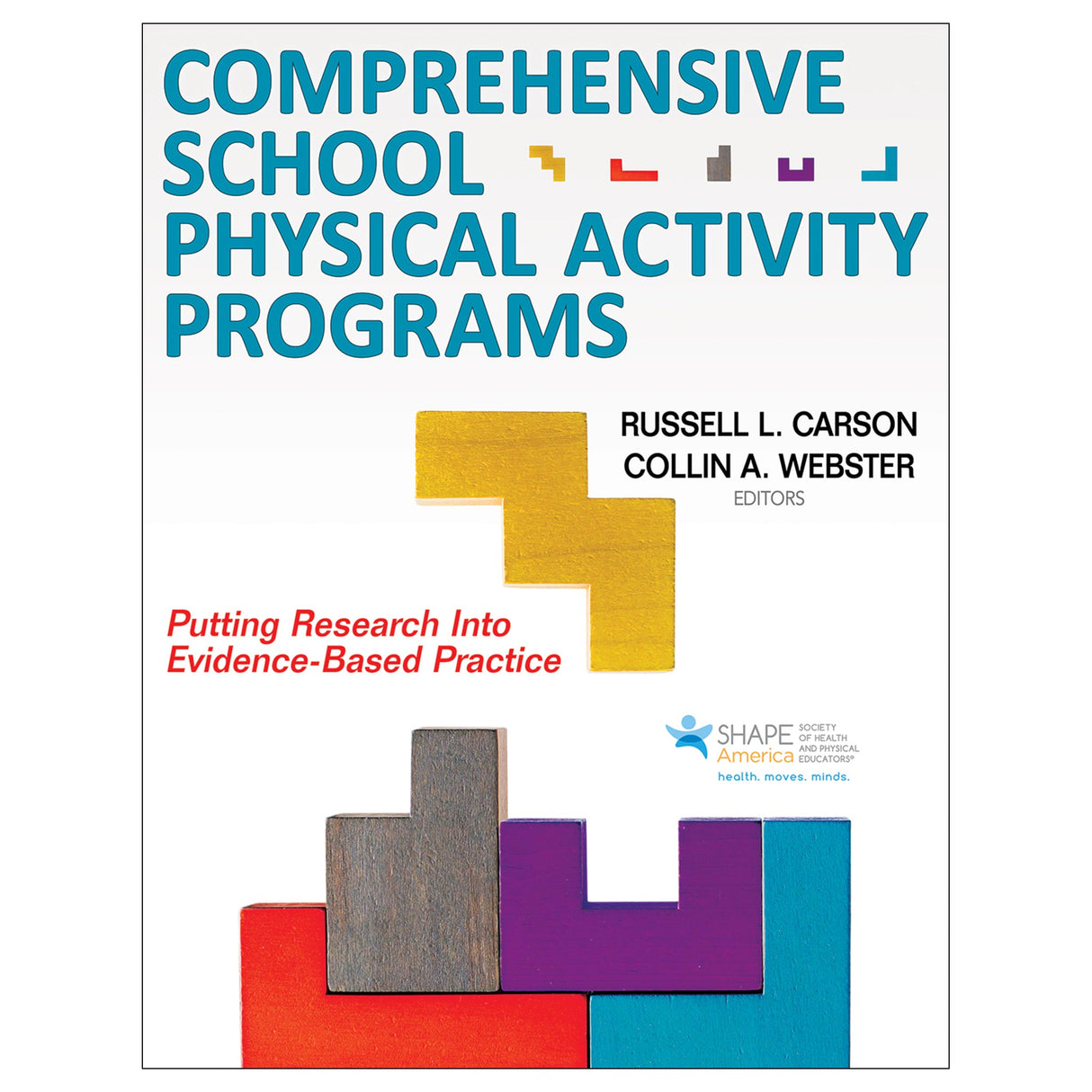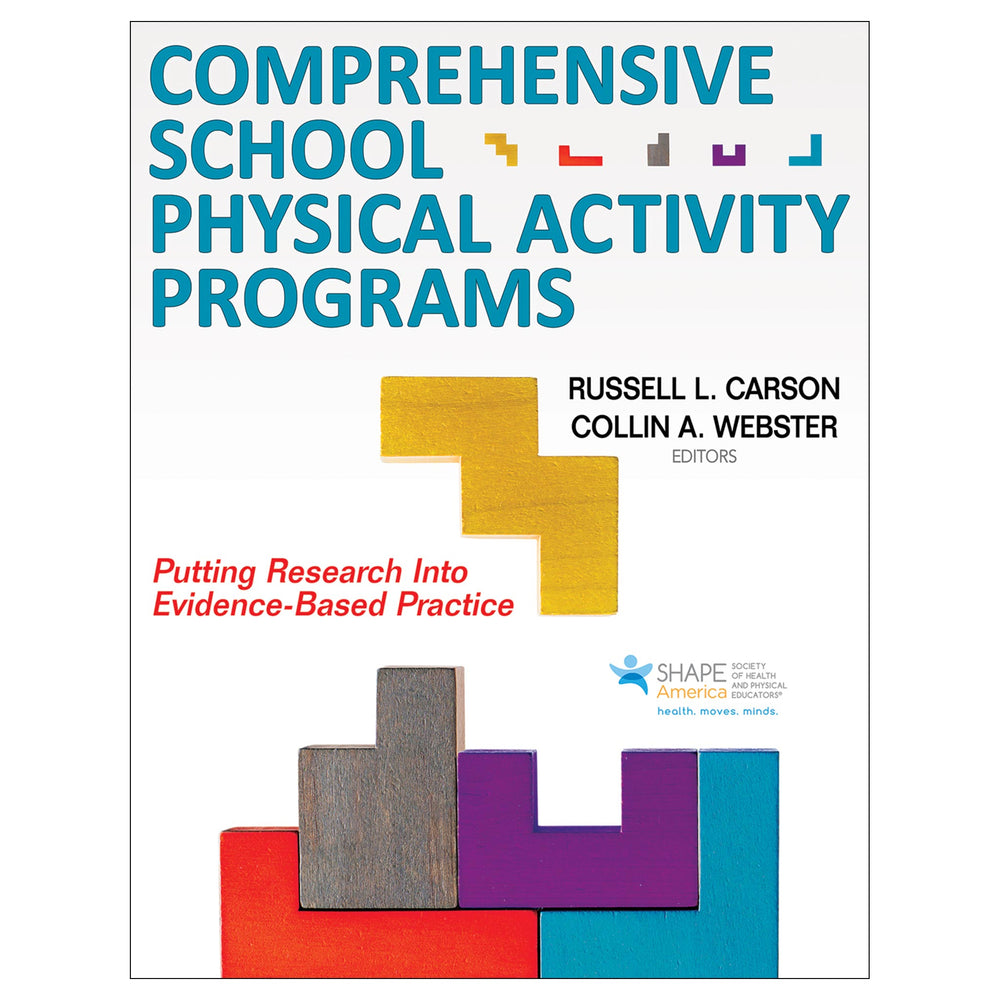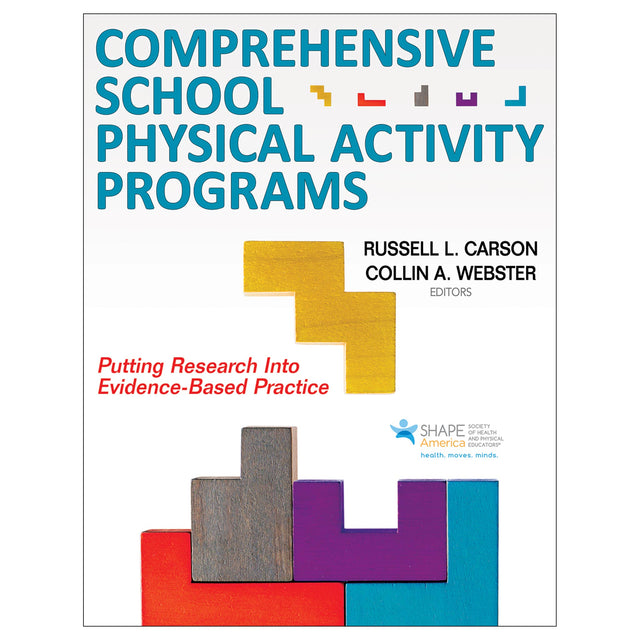Comprehensive School Physical Activity Programs
Putting Research into Evidence-Based Practice
Author: Russell Carson, Collin A. Webster
$59.00 CAD
That’s where Comprehensive School Physical Activity Programs: Putting Research Into Evidence-Based Practice comes in.
CSPAP Model Brought to Life
The comprehensive school physical activity program (CSPAP) model, originally outlined as a 2008 position statement by the National Association for Sport and Physical Education to promote physical activity throughout K-12, is brought to life through this comprehensive, all-in-one resource. In the decade since that position statement, CSPAP has been spreading through numerous initiatives, which have mobilized a CSPAP field of study and a national framework for physical activity and physical education. CSPAP acts as a hub, supporting physical activity through multiple components that can include physical education; physical activity before, during, and after school; staff involvement; and family and community engagement. Moreover, each CSPAP component can serve to strengthen and reinforce the academic goals of physical education.
Accommodates Needs of Diverse Audiences
Comprehensive School Physical Activity Programs, published in association with SHAPE America, accommodates the growing needs of academic researchers, school practitioners, district coordinators, educators, advocates, organizations, university faculty, and students who want to learn more about CSPAP or undertake ways to increase daily physical activity opportunities in and around schools.
The Text’s Strengths
This text does all of the following and more: Synthesizes all the foundational and emerging research, theory, and practice on CSPAP
- Synthesizes all the foundational and emerging research, theory, and practice on CSPAP
- Provides a higher- and deeper-level look at the CSPAP model, as opposed to short reports and position papers, which contain limited strategies for schools
- Offers much more in-depth coverage of the CSPAP model by delving into assessment, evaluation, advocacy, policy, partnerships, international perspectives, technology, and more
Comprehensive School Physical Activity Programs was written by a diverse team of pioneers and leaders in the CSPAP field. This team brings national and international perspectives on all aspects related to implementing and maintaining CSPAP in K-12 schools. These recognized experts provide incisive guidance in, and understanding of, the most prominent concepts, issues, and developments in the field.
Book Organization
The text is organized into six sections:
- Part I provides the historical and foundational perspectives and policy landscapes of the CSPAP approach.
- Part II outlines internal, external, and psychological factors to consider in program design, implementation, and sustainability.
- In part III, the contributors examine and interpret the research on the effectiveness of established programs and previous interventions.
- Part IV highlights special considerations for effective programming within urban and rural settings, reviews current and ongoing international CSPAP initiatives, and addresses the application of the model to alternative contexts beyond the K-12 school setting.
- In part V, the contributors focus on using assessments to determine the physical activity promotion needs of a school community, on the instruments and procedures for measuring school-wide programming, and on the processes for evaluating and advocating for CSPAPs.
- Part VI examines current reform efforts within preprofessional programs in teacher education, reviews the tools and future potential for using technology to deliver and assess CSPAP efforts, and looks at future directions for the disciplines of study that inform the CSPAP knowledge base.
An Invaluable Resource
The rapid growth of the field and the increasing number of diverse and exceptional scholars (many of whom are contributors to this book) are indications of the need for this resource. Comprehensive School Physical Activity Programs offers unique perspectives about how to generate and sustain successful initiatives to increase youth physical activity and promote long-term engagement in active behavior. It provides access to leading thought, invaluable tools, and challenging questions that will propel the CSPAP field to its next level of depth and clarity.
Human Kinetics is proud to publish this book in association with SHAPE America, the national organization that defines excellence for school-based health and physical education professionals across the United States.
Audience
Reference for K-12 teachers, administrators, and district coordinators. Textbook for instructors and students in PETE (physical education teacher education) undergraduate and graduate programs. Resource for physical education and physical activity researchers.Chapter 1. CSPAPs: History, Foundations, Possibilities, and Barriers
Hans van der Mars and Kent A. Lorenz
Emergence of CSPAPs
History and Emergence of CSPAPs
CSPAP’s Roots Within Public Health and National Physical Activity Recommendations
CSPAP’s Theoretical Roots
Why CSPAPs: A Critical (and Final?) Opportunity to Thrive
Possibilities of CSPAPs
Barriers to Overcome
Learning Aids
Chapter 2. Emerging Policy Landscape Surrounding CSPAPs
Justin B. Moore, Abigail Gamble, David Gardner, Alexandra Peluso, and Danny Perry
Review of Research
Knowledge Claims
Knowledge Gaps and Directions for Future Research
Evidence-Based Recommendations and Applications
Learning Aids
Case Example
Part II. Conceptual Models for CSPAP Implementation
Chapter 3. Internal Capacity Building: The Role of the CSPAP Champion and Other School Professionals
Russell L. Carson, Catherine P. Abel-Berei, Laura Russ, Jessica Shawley, Tanya Peal, and Cyrus Weinberger
Review of Research
Knowledge Claims
Knowledge Gaps and Directions for Future Research
Evidence-Based Recommendations and Applications
Learning Aids
Case Examples
Chapter 4. Capitalizing on Internal–External Partnerships to Maximize Program Sustainability
Collin A. Webster, Cate A. Egan, and Kevin Brabham
Review of Research
Knowledge Claims
Knowledge Gaps and Directions for Future Research
Evidence-Based Recommendations and Applications
Learning Aids
Case Example
Chapter 5. Social Psychological and Motivational Theoretical Frameworks for CSPAP Intervention
Megan Babkes Stellino, Spyridoula Vazou, Lyndsie M. Koon, and Katie Hodgin
Review of Theoretical Frameworks for CSPAP Research and Intervention
Description of Theoretically Guided Efforts Across CSPAP Components
Knowledge Claims
Knowledge Gaps and Directions for Future Research
Evidence-Based Recommendations and Applications
Learning Aids
Case Examples
Part III. Research on Program Effectiveness
Chapter 6. Quality Physical Education
Kim C. Graber, Chad M. Killian, and Amelia Mays Woods
Review of Research
Knowledge Claims
Knowledge Gaps and Directions for Future Research
Evidence-Based Recommendations and Applications
Learning Aids
Case Example
Chapter 7. Physical Activity During School
Aaron Beighle, Heather Erwin, Collin A. Webster, and Michelle A. Webster
Review of Research
Knowledge Claims
Knowledge Gaps and Directions for Future Research
Evidence-Based Recommendations and Applications
Learning Aids
Case Examples
Chapter 8. Physical Activity Programs Before and After School
Brian Dauenhauer, Megan Babkes Stellino, Collin A. Webster, and Chuck Steinfurth
Review of Research
Knowledge Claims
Knowledge Gaps and Directions for Future Research
Evidence-Based Recommendations and Applications
Learning Aids
Case Examples
Chapter 9. Staff Involvement
Collin A. Webster, R. Glenn Weaver, Martha Carman, Lee Marcheschi, Athanasios (Tom) Loulousis, Spyridoula Vazou, Tan Leng Goh, and Russell L. Carson
Review of Research
Knowledge Claims
Knowledge Gaps and Directions for Future Research
Evidence-Based Recommendations and Applications
Learning Aids
Case Examples
Chapter 10. Family and Community Engagement
Gregory J. Welk and Joey A. Lee
Review of Research
Knowledge Claims
Knowledge Gaps and Directions for Future Research
Evidence-Based Recommendations and Applications
Learning Aids
Case Example
Chapter 11. Multicomponent Optimization Strategy and CSPAP Implementation
Ashley Phelps, Yeonhak Jung, and Darla M. Castelli
Review of Research
Knowledge Claims
Knowledge Gaps and Directions for Future Research
Evidenced-Based Recommendations and Applications
Learning Aids
Case Examples
Part IV. Contextual Considerations
Chapter 12. CSPAPs in Urban Contexts
Sarah Doolittle, Paul Rukavina, and Kevin Mercier
Review of Research
Knowledge Claims
Knowledge Gaps and Directions for Future Research
Evidence-Based Recommendations and Applications
Learning Aids
Case Example
Chapter 13. CSPAPs in Rural Settings
Pamela Hodges Kulinna, Michalis Stylianou, Kent A. Lorenz, Shannon C. Mulhearn, Tom Taylor, Shawn Orme, and Alan Everett
Review of Research
Knowledge Claims
Knowledge Gaps and Directions for Future Research
Evidence-Based Recommendations and Applications
Learning Aids
Case Example
Chapter 14. International Perspectives and Initiatives
Jaimie M. McMullen, Déirdre Ní Chróinín, Michalis Stylianou, and Tuija Tammelin
Review of Research
Knowledge Claims
Knowledge Gaps and Directions for Future Research
Evidence-Based Recommendations and Applications
Learning Aids
Case Examples
Chapter 15. Implementation of CSPAPs in Nontraditional Settings
Timothy A. Brusseau and James C. Hannon
Review of Research
Knowledge Claims
Knowledge Gaps and Directions for Future Research
Evidence-Based Recommendations and Applications
Learning Aids
Case Example
Part V. Developing, Measuring, and Promoting CSPAPs
Chapter 16. Conducting a Systematic Needs Assessment for CSPAP Success
Eloise Elliot, Sean Bulger, Emily Jones, and Alfgeir Kristjansson
Review of Research
Knowledge Claims
Knowledge Gaps and Directions for Future Research
Evidence-Based Recommendations and Applications
Learning Aids
Case Example
Chapter 17. Assessing School Physical Education and Physical Activity Programs: Selected Tools
Thomas L. McKenzie
Systematic Observation Tools
Self-Report Tools
A Summary Score and an Advocacy Tool
Evidence-Based Recommendations and Applications
Learning Aids
Case Examples
Chapter 18. Evaluating CSPAPs: Measuring Implementation and Impact
Erin E. Centeio and Nate McCaughtry
Review of Research
Knowledge Claims
Knowledge Gaps and Directions for Future Research
Evidence-Based Recommendations and Applications
Learning Aids
Case Example
Chapter 19. Advocating for CSPAPs
Heather E. Erwin and Erin E. Centeio
Review of Research
Knowledge Claims
Knowledge Gaps and Directions for Future Research
Evidence-Based Recommendations and Applications
Learning Aids
Case Examples
Part VI. Looking to the Future
Chapter 20. Preparing Preservice Physical Education Teacher Educators for CSPAP Implementation
Grace Goc Karp, Helen Brown, Ja Youn Kwon, and Pamela Hodges Kulinna
Review of Research
Knowledge Claims
Knowledge Gaps and Directions for Future Research
Evidenced-Based Recommendations and Applications
Learning Aids
Case Example
Chapter 21. Progress and Possibilities for Technology Integration in CSPAPs
Zan Gao, Zachary Pope, Nan Zeng, Daniel McDonough, and Jung Eun Lee
Review of Research
Knowledge Claims
Knowledge Gaps and Directions for Future Research
Evidence-Based Recommendations and Applications
Learning Aids
Case Example
Chapter 22. A Synergized Strategy Guide for Advancing the Field
Russell L. Carson and Collin A. Webster
How Does the Policy Landscape Reflect the Evolving Values and Traditions of the CSPAP Model?
What Conceptual and Theoretical Approaches Could Guide CSPAP Practice and Collaboration?
How Does Context Factor Into Best Practices for CSPAPs?
What Are Some Promising Strategies for Planning, Evaluating, and Promoting CSPAPs?
What Are the Potential Contributions of Preservice Education and Technology Integration in CSPAP Research and Practice?
Advancement Strategies
Summary
Collin Webster, PhD, earned his doctorate in physical education and sport studies from the University of Georgia in 2006 and has held academic appointments at the University of South Carolina and the University of Wollongong in Australia. He is a nationally and internationally recognized scholar in the area of youth physical activity promotion, particularly comprehensive school physical activity programs.
Evaluating CSPAPs
Internal Capacity Building: The Role of the CSPAP Champion
Human Kinetics is pleased to partner with SHAPE America by offering discounts on our resources to SHAPE America members! Whether you’re a preK-12 teacher, higher education faculty member, researcher, administrator, or future professional, we’re here to help you in your professional career and personal fitness journey of improved fitness, stronger athletic performance, and better nutrition.
SHAPE America members receive a 30% discount on this resource and other eligible resources through the member portal at SHAPE America. Learn more about SHAPE America membership at SHAPEAmerica.org or direct your questions about the discount to askmembership@shapeamerica.org.





